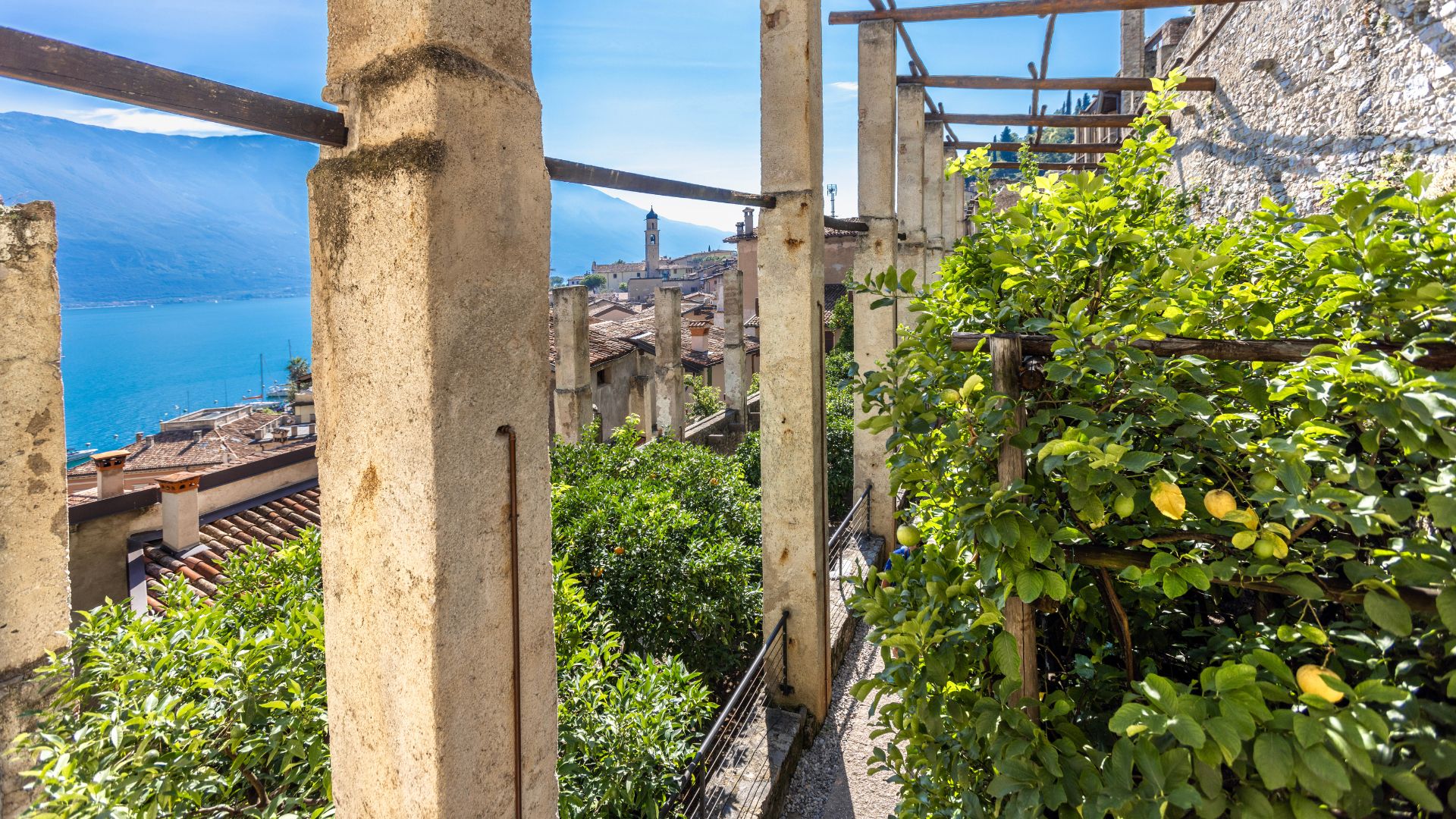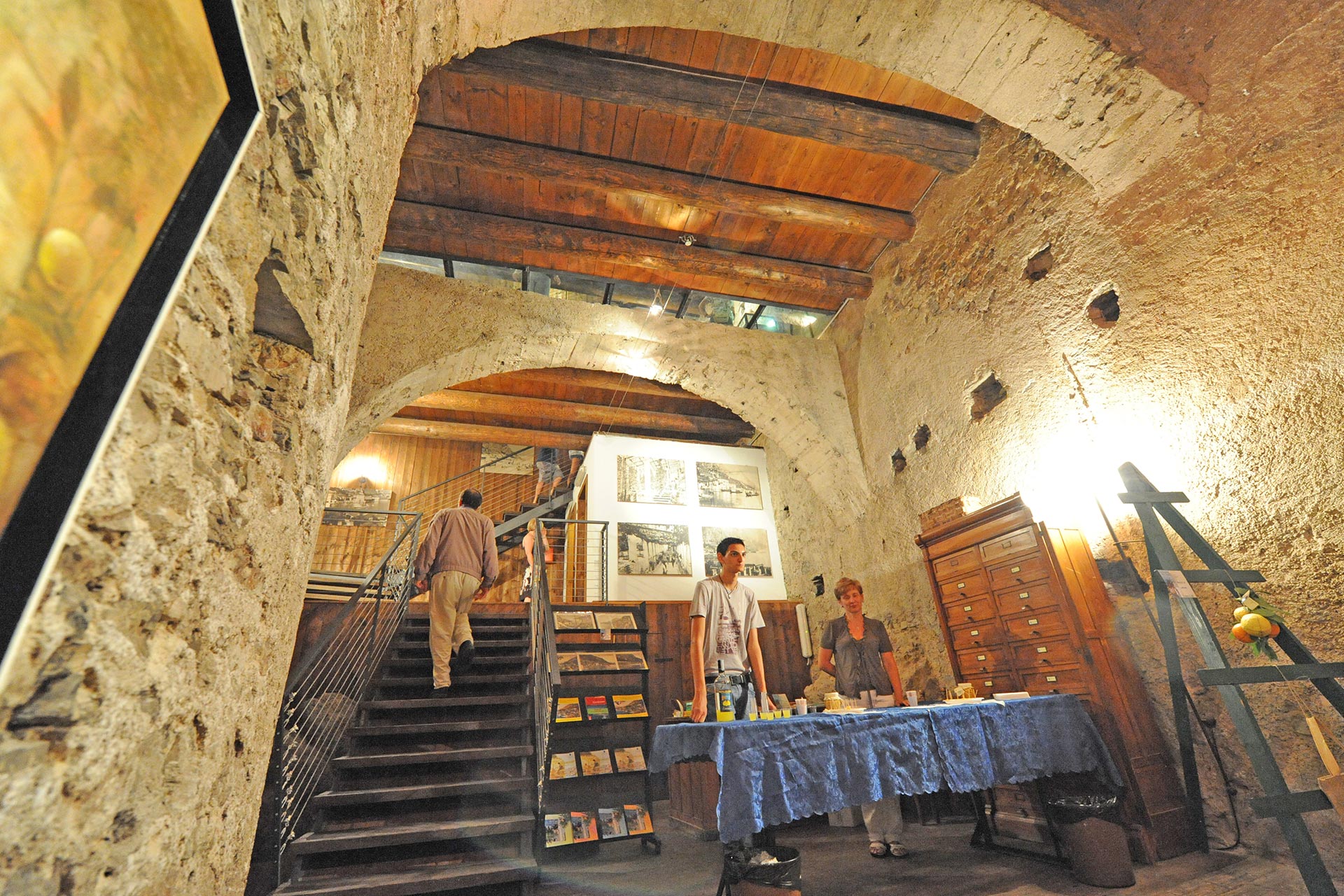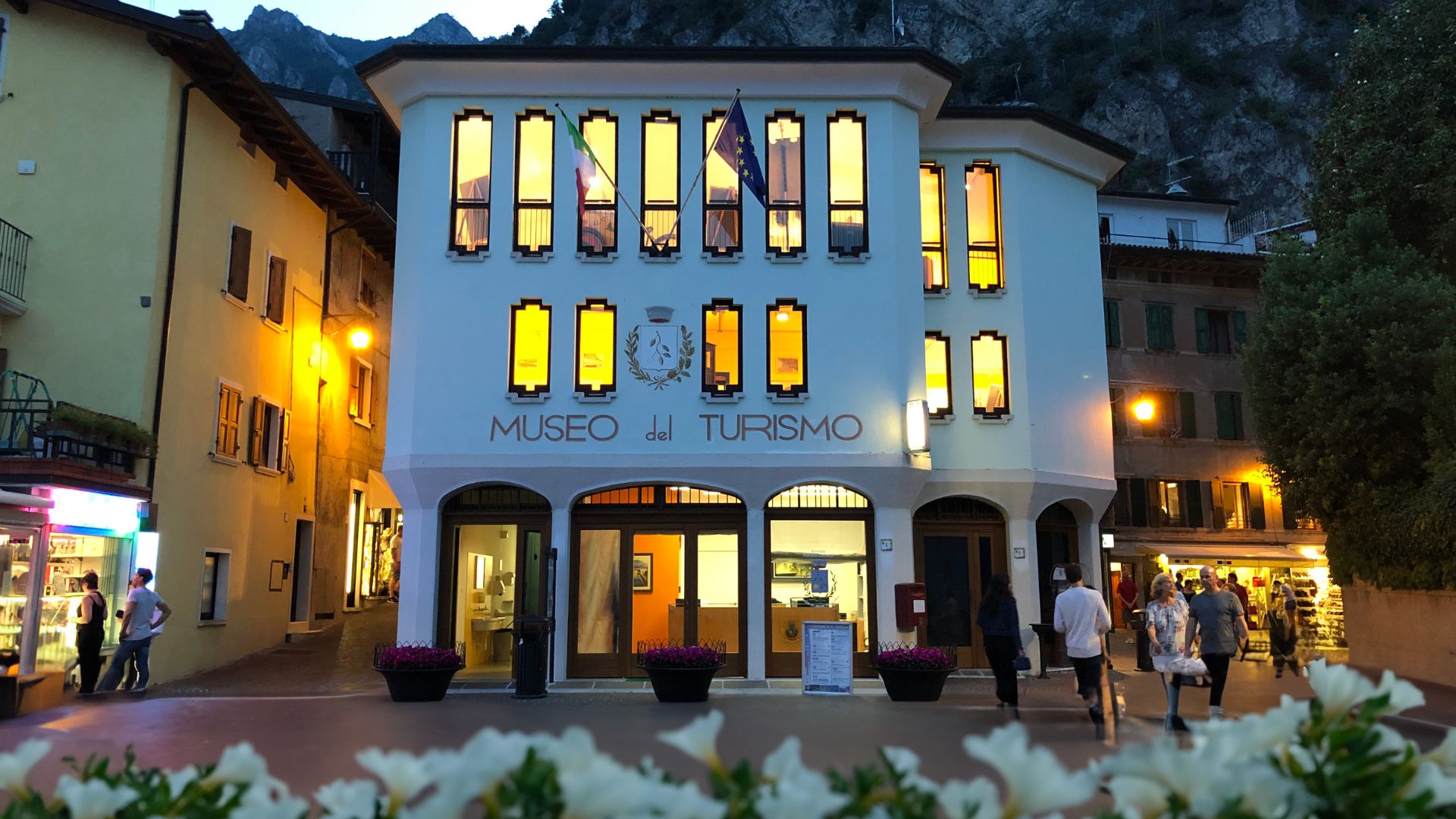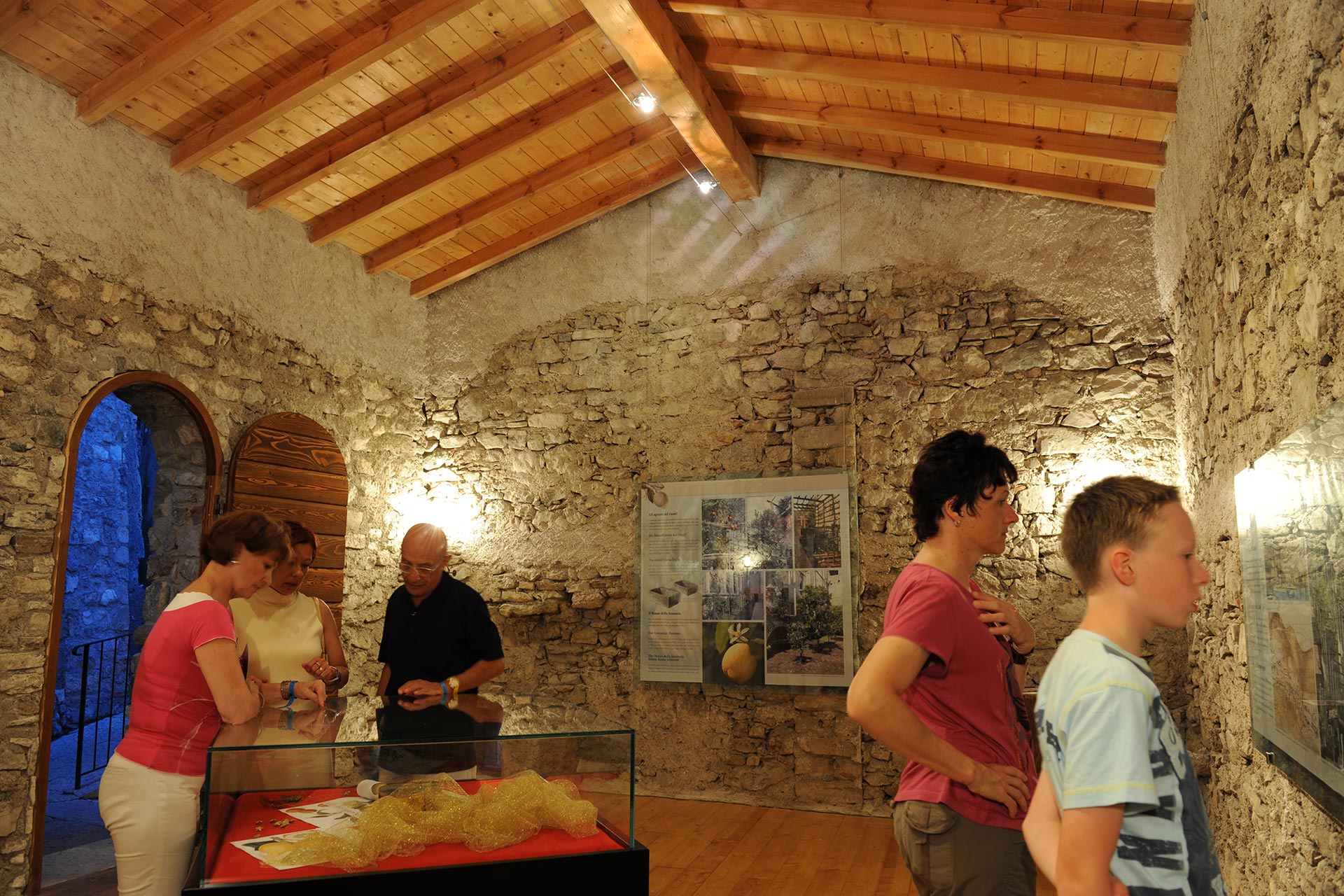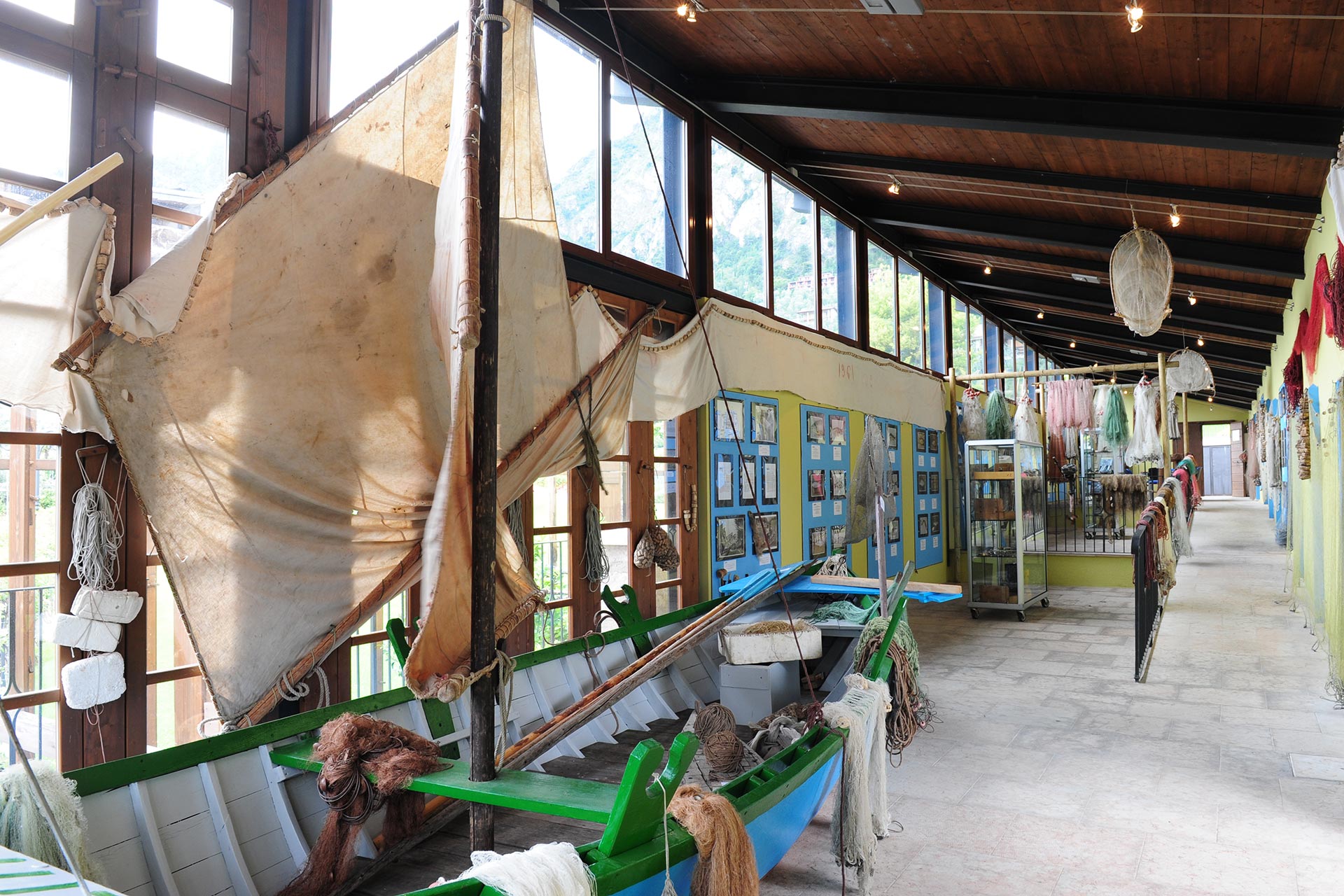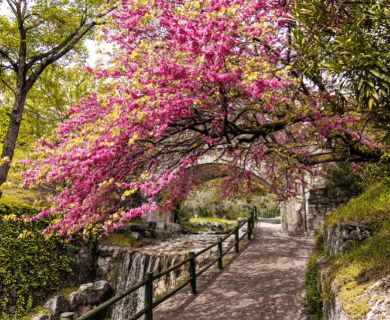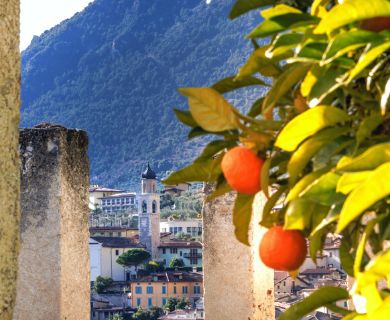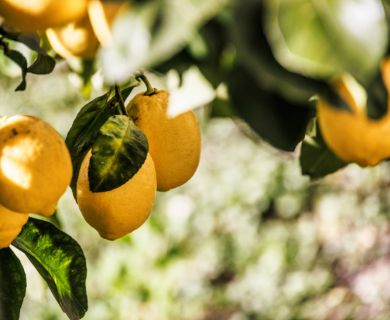Museums in Limone sul Garda
Limone sul Garda is not only sport, outdoor activities, and relaxation on the beaches: it is much more. For those who love history, art and culture, this small town on the shores of Lake Garda offers an incredible dive into the past: lemon houses, museums, churches, and olive groves.
Come and discover the artistic and cultural treasures of Limone!
The Limonaia del Castèl
Facing the sun to catch its rays, the white pillars, and walls of the unique "Limonaie", the lemon gardens, still stand out along the lake shore. There are only traces of them on the lake between Gargnano and Limone, evidence of a glorious past.
In 1995, the Municipal Administration purchased the "Limonaia del Castèl" with the intention of enhancing this heritage, restructuring it, and putting it back into use, planting over a hundred citrus trees, restoring the terracing and the irrigation system, and arranging the tool sheds, which have also become an educational trail.
To facilitate access to the Limonaia, ceramic tiles have been placed on the streets in the center.
To the north-west of the historic center, leaning against the rocks of the Mughéra, the Limonaia del Castèl is now only part of the large production structure that once reached the Màndola valley from the Mura valley, Pozze Street and Castello Street. The garden, which has a surface area of 1,633 square meters, is divided perpendicularly into two parts by the cùen dela Marches'àna, on which the main casèl is built, with several floors: in the southern part, it extends for a stretch on a single còla, for another on three; in the northern part it extends on four còles, which border northwards with the valèt del Castèl, on which another small casèl is built.
Its construction dates to the early 18th century. It is clear, however, that the lemon house has undergone various alterations over time. The date "15 April 1786", still visible in a water collection well, could refer to the construction or adaptation of the channels in the còle. Other interventions were carried out to raise and move pillars, to raise the walls and to increase the walking surface and the number of floors of the cas'èl. The Limonaia passed from the Amadei family to the Bertoni and Patuzzi families and, in the 19th century, to the Girardi and Polidoro families. On 19 June 1926, the deed was bought by Giuseppe Segala (1889-1975), who had returned to Limone from America after years of hard work as a miner. Four building works were carried out: the first in 1997 for the construction of a wall, the replacement of sparadòs and cantér and the cleaning of the còle; the second in 1999 for the reconstruction of the roof of a cas'èl; the third in 2002-03, thanks to a specific contribution from the Lombardy Region under the "2000-2006 Rural Development Plan", for the conservative restoration of two casèi and two còle. In the winter of 2006-2007, with funds from the Municipal Administration, the works on the casèi/entrance building and the lower terrace were completed. The central cas'èl serves as a link between the terraces and is equipped as a museum-didactic center. In all the còle there are canals for irrigating the plants; the water came from the San Giovanni stream through the Calmèta conduit, which dates to the early 18th century. In the Limonaia, inaugurated on 22 July 2004, about a hundred citrus fruits are grown (citrons, lemons, sweet and bitter oranges, chinottos, grapefruits, mandarins and kumquats).
-
Entrance € 2.00
Children under 10 years old enter for free
Free entry in the winter season
The contribution goes towards the maintenance and enhancement of the Limonaia. -
from 6 DECEMBER: Saturdays, Sundays and holidays
from DECEMBER 26th to JANUARY 6th 2026 every day
from 10:00 to 17:00
For further information, or to book guided tours, please contact the Town Hall office during office hours at 0365 954008.
Museum of Tourism
In order to document the socio-economic changes that have taken place in the town since the opening of the Gardesana road, the town council has promoted the creation of the "Museum of Tourism".
Set up in the former Town Hall and inaugurated in 2011, the museum houses collections of posters, calendars, travel guides, souvenirs, etc. Ample space was also given to our fellow citizen Saint Daniele Comboni and to the discovery of Apoliprotein A1-Milano, a beneficial genetic mutation that prevents heart attacks and cardiovascular diseases, discovered in the blood of some inhabitants of Limone sul Garda.
Once the Gardesana road was built (1929-1931), providing a link to Gargnano and Riva, Limone became one of the most popular tourist resorts on Lake Garda in the second half of the 20th century. Many factors influenced its development: its position on the lake, the morphology of the land, the characteristic shape of its historic center, the climatic conditions, the activism of its inhabitants, and the attention of public administrators.
In little more than fifty years, campsites, and rooms to let have been opened, followed by the birth of inns, hotels, flats, residences, bars, restaurants, and shops that have transformed the face of the town and the lives of the people. Tourism, almost exclusively foreign, is now practically the only economic activity in Limone. In order to collect documents, images, testimonies, etc. relating in any way to the birth and development of tourism, the municipal administration has promoted the creation of the "Museum of Tourism". As well as Limone in general, the research and collection of documentation also concerns individual tourist businesses and operators in the sector (entrepreneurs, employees, collaborators, etc.). Everyone is welcome to collaborate with the museum, which will gradually grow, by providing material and testimonials.
Former Town Hall, via Comboni n. 3
Opening hours:
The Museum is open to the public from 01.04.2025 every day until 31.10.2025, from 10 am to 10 pm.
Free entrance.
The Ancient Oil Mill and the Oil Exhibition
Thanks to the mild climate of Lake Garda, olive growing was one of the most prosperous economic activities in the past. However, the special care the olive tree requires and consequently the high production costs, as well as the strong competition from Mediterranean countries, meant that in the post-war years the sector became less and less competitive. However, the olive grove is one of the special features of our locality and the silvery foliage of these centuries-old trees frames the entire hinterland.
The tradition of their cultivation continues to this day and the Cooperativa Possidenti Oliveti, which brings together all the olive growers of Limone, still produces a top-quality PDO extra virgin olive oil, cold-pressed with stone millstones, in its old mill.
The oil mill is open from 17th April to 10th October 2025 from 10 a.m. to 12 noon and from 4 p.m. to 6 p.m., Monday to Friday, with free admission.
For information: Cooperativa Agricola Possidenti Oliveti - Tel: 0365/954446
Fishermen's Museum
The massive socio-economic change that involved the town after the opening of the Gardesana road also affected fishing, which was gradually abandoned. A typical boat and the tools that our grandparents used every day in this work, together with cards on the fish that inhabit the lake, recipes of typical dishes based on lake fish and period photos, are now kept in this interesting museum, which is housed in the Limonaia of Villa Boghi.
The Municipal Administration of Limone sul Garda wanted to create this Fishermen's Museum to keep alive in the memory the history of the "old trades" and "traditions" of the inhabitants of this town.
Limone sul Garda, once a small village linked to the simple rural economy of growing olives and fishing, then in the 1700s it moved on to the construction of lemon houses and the cultivation of citrus fruits. Thanks to many favorable conditions, the continued commitment of its inhabitants and the attention of its administrators, it has become one of the most important tourist centers on Lake Garda and is now known throughout Europe.
The Fishermen's Museum is located in the historic center on Via Porto Ragni, easily reachable from the lakefront. Along this small and picturesque street, typical of ancient historic centers, visitors can discover in a single space the old rural traditions and appreciate the economic development and transformation of this former fishing village.
The Fishermen's Museum has a collection of objects, photos, and various materials related to the traditional trade on the lake. Everything has been generously donated by family members of former fishermen and by the fishermen of the Association, who have thus actively contributed to the creation of the museum to commemorate an important part of the history of Limone sul Garda.
Opening hours:
Every day from 01.04.2025 to 31.10.2025 from 10.00 a.m. to 10.00 p.m.
Admission free
For information, also at other times/days: Tel. 0365 954720, during office hours.
The Comboni Missionary Center
Limone sul Garda was the birthplace of Saint Daniele Comboni, a great man whose heroic virtues and missionary work were recognized with his beatification in 1996 and, on 5 October 2003, with his canonisation.
At the Comboni Center of "Tešöl", immersed in the lemon grove of the same name and surrounded by a park, visitors have the opportunity to deepen their knowledge of our fellow citizen by visiting the Birthplace, the small church built from the old woodshed, the "Museum of Curiosities", the multimedia path and the adjacent exhibition. For further information see the Museums Tour guide.
It is an honor for our town to have been the birthplace of Daniele Comboni (15 March 1831), founder of the Comboni Institutes, so we believe that the Comboni Centre in the "Tesöl" is worth a visit, both to understand the importance of the missionary institution he created and to appreciate the serenity inspired by this characteristic place. In order to realize his great dream and goal "To save Africa with Africa", Comboni did not hesitate to involve the whole Church, because he was convinced that his was "God's work". It was a bold undertaking for those times, supported by an unshakeable faith and a love that knew no boundaries, which led him several times to risk his life during missionary expeditions. The difficulties he encountered along the way did not stop him, and faithful to his motto "Either Nigrizia or Death", he continued with his intentions, founding in 1867 "the Institute for the Missions of Nigrizia" and in 1872 the Institute of the "Pious Mothers of Nigrizia". He spent all his energies in his apostolic work for the African people and died, crushed by fever, in Khartoum (Sudan) on 10th October 1881. The work of the missionary institutes continued successfully and about a century later the Secular Institute of Comboni Missionaries was founded in 1969 and the Comboni Lay Missionaries in 1990. For his heroic virtues and missionary work, Daniel Comboni was beatified in Rome by Pope John Paul II in St. Peter's Basilica on 17th March 1996 and made a saint on 5th October 2003. At the Comboni Center in "Tesöl" you will have the opportunity to learn more about Daniel Comboni's life and to visit his birthplace consisting of the simple kitchen, the adjacent parents' bedroom, adorned with letters addressed to them by the Monsignor, the children's bedroom above connected to the kitchen by a wooden staircase; in the little church, created from the old woodshed below the birthplace, you can see the altar in olive wood, the wrought-iron tabernacle and the wooden works by the South Tyrolean sculptor Paolo Mussner (the Holy Family, the crucifix and the lectern); in the museum-exhibition gallery there is a brief outline of the African peoples and culture of the regions where Comboni worked, while the multimedia route offers the possibility of deepening one's knowledge of Saint Daniele Comboni.
Park, Church, Birthplace, Museum of Curiosities are open every day from 9.30 am to 8.30 pm. The Multimedia Route and Exhibition are open every day, except Mondays, from 1st April to 31st October from 9.30 am to 12 noon and from 3 pm to 6.30 pm. From 1st November to 31st March, bookings can only be made by telephone or e-mail.
For group visits and other information: Tel: 0365/954091 during office hours, or send an e-mail to combonianilimone@gmail.com
Museum of Curiosities
At the Comboni Center of "Tesöl" a small but interesting "Museum of Curiosities" has recently been set up and we recommend you visit it. There are various exhibits on display, mostly of animal origin, collected over the years by the missionaries in every corner of the world, appropriately ordered and catalogued.
Among the various objects on display are several species of shells, including a "Tridacna gigas" weighing 155 kg. (one of the largest mollusks in the world) and a variety of fossils of fish, mammals, reptiles (apatosaurus bones, dinosaur eggs, etc.) and shells.
Also collected are small marine animals (sponges, corals, etc.), other casts of fossil animals, minerals (including a meteorite that fell in China in 1516), the teeth of five different types of sharks, rare insects, and crustaceans as well as a python and anaconda skin.
A showcase contains a few special exhibits, including stone tools, hunting implements and weapons belonging to "prehistoric" man and autographed photographs of astronauts from "technological" man.
